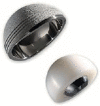Third generation Dual Mobility Cups: could be the future in total hip arthroplasty? A five-year experience with dualis
- PMID: 35604267
- PMCID: PMC9437685
- DOI: 10.23750/abm.v92iS3.12541
Third generation Dual Mobility Cups: could be the future in total hip arthroplasty? A five-year experience with dualis
Abstract
Background: The concept of dual mobility (DM) is currently approved as a valid option for reducing the risk of dislocation, with an incidence ranging from 0% to 4.6%. The principle is to achieve a high joint stability through a large diameter polyethylene (PE) liner, and to reduce cutting forces due to a "low-friction" head-liner coupling mechanism.
Methods: From March 2015 to March 2020, 138 patients were treated with Dualis Cup (Gruppo Bioimpianti-Peschiera Borromeo, MI, Italy) for a total of 141 implants (three cases were bilateral). The average age at the time of the surgery was 77. Patients' clinical and X-ray follow-up was at 1, 3, 6, 12 months and then once a year.
Results: Seven patients (4.9%) had complications which required a second surgery, but only one case (0.7%) of intraprosthetic dislocation (which required cup revision), was directly ascribable to the DM cup.
Conclusions: Improvements in design and materials of the third generation DM cups allowed both to reduce the rate of dislocations in high-risk patients (i.e., patients with neuro-muscular diseases and cognitive disorders, patients needing revisions, osteosynthesis failures, femoral neck fractures) and to achieve a survival rate similar to standard cups, ensuring a range of motion (ROM) very close to the physiological one. In our brief experience, Dualis Cups showed results comparable to those reported in the literature for Dual Mobility. If this data is confirmed by long-term studies, the use of DM cups could be extended even for young patients with high functional demands. (www.actabiomedica.it).
Figures





References
-
- Noyer D, Groupe G. La troisième articulation des prothèses de hanche à double mobilité. Maitrise Orthop. 2003;121:20–2.
-
- Lecuire F, Benereau I, Rubini J, et al. Intra-prosthetic dislocation of the Bousquet dual mobility socket. Rev Chir Orthop Repar Appar Mot. 2004;90:249–55. - PubMed
-
- Neri T, Boyer R, Geringer J et al. Intraprosthetic dislocation of dual mobility total hip arthroplasty: still occuring? Int Orthop. 2019 May;43(5):1097–105. - PubMed
MeSH terms
LinkOut - more resources
Full Text Sources
Medical

